 The use of fertilizers in growing tomatoes has long been commonplace. Particular attention in the first weeks of growing seedlings is given to ammonia additives. Thanks to nitrogen derivatives, the number of green leaves and young shoots increases, and the root system develops rapidly. Nitrogen by itself is poorly absorbed in the soil, therefore, its ammonium, ammonia, nitrite compounds are most often used. These substances include ammonia. It is often used as a top dressing for tomato seedlings, and is also an excellent insect repellent.
The use of fertilizers in growing tomatoes has long been commonplace. Particular attention in the first weeks of growing seedlings is given to ammonia additives. Thanks to nitrogen derivatives, the number of green leaves and young shoots increases, and the root system develops rapidly. Nitrogen by itself is poorly absorbed in the soil, therefore, its ammonium, ammonia, nitrite compounds are most often used. These substances include ammonia. It is often used as a top dressing for tomato seedlings, and is also an excellent insect repellent.
Content
Description and useful properties
Ammonium chloride is a substance with a sharp specific odor. By its chemical structure, it contains ammonia, which is highly soluble in water. Ammonia decomposes well in the soil, instantly has an effect on tomatoes. When decay does not form toxins and side harmful elements.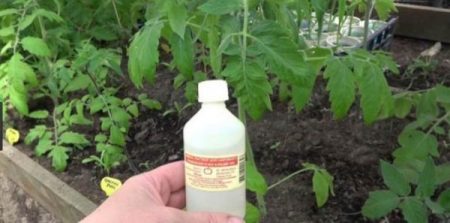
The advantages of fertilizing with ammonia include:
- its cheapness and wide distribution;
- visible result. The effect can be replaced after the first application;
- safety of use. With the right dosage, there is no danger to the plant.
Once in the soil, ammonia actively nourishes the roots. With the development of the root system, an increase in green mass is noted, the stems become thick, and flowering occurs faster. The substance is especially useful for those plants that, after transplanting into the greenhouse, have slowed down, have fragile stems, and the leaves periodically dry and grow smaller. In addition, the supplement enhances the immune properties of tomatoes, they tolerate frost more easily, and the shelf life of ripe fruits increases by a couple of weeks.
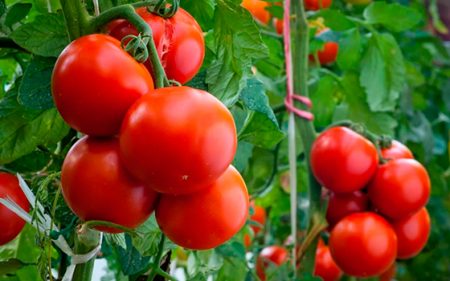 Feeding with ammonia is carried out 3-4 times for the entire growing period, mainly in the first phase of tomato growth. With an excess of ammonia in the soil, the opposite effect is observed - tomatoes fatten, after abundant flowering, ovaries form poorly. In this case, top dressing is stopped until the mineral balance is restored in the soil. Also, abuse of the supplement leads to the formation of fungal infections on the stems and leaves.
Feeding with ammonia is carried out 3-4 times for the entire growing period, mainly in the first phase of tomato growth. With an excess of ammonia in the soil, the opposite effect is observed - tomatoes fatten, after abundant flowering, ovaries form poorly. In this case, top dressing is stopped until the mineral balance is restored in the soil. Also, abuse of the supplement leads to the formation of fungal infections on the stems and leaves.
Types of Feeding
Ammonia must be diluted with water before use. The resulting solution is used to treat shoots and soil on which seedlings are grown.
Feeding with ammonia is carried out in 3 stages:
First step
When the tomatoes are already transplanted into the greenhouse, after 2 weeks they carry out the first feeding. Usually this time falls in mid-May. Pour warm water into a bucket and add 1 barrel spoon of ammonia and stir. The procedure is carried out quickly, since ammonia evaporates, and its concentration decreases - it means the mixture loses its healing properties. 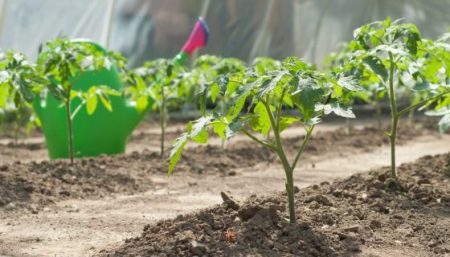 Pour the water mixture into a watering can and pour the tomatoes under the root at the rate of 1 liter per 1 bush. Watering is preferably carried out in the morning.
Pour the water mixture into a watering can and pour the tomatoes under the root at the rate of 1 liter per 1 bush. Watering is preferably carried out in the morning.
When breeding fertilizer, gloves and safety glasses must be used. If it comes into contact with the skin, it causes an allergic reaction and itching.
Second phase
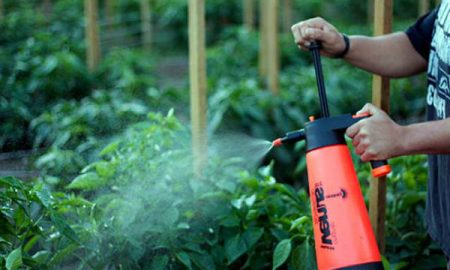 The second stage of use of the additive occurs in the phase before flowering - in early June. Dissolve a teaspoon of ammonia in a bucket of water and irrigate shoots and leaves with a spray gun or spray gun. Processing is carried out in the morning or in the evening. It is forbidden to irrigate tomatoes in the afternoon, as plants can get burned.
The second stage of use of the additive occurs in the phase before flowering - in early June. Dissolve a teaspoon of ammonia in a bucket of water and irrigate shoots and leaves with a spray gun or spray gun. Processing is carried out in the morning or in the evening. It is forbidden to irrigate tomatoes in the afternoon, as plants can get burned.
Third stage
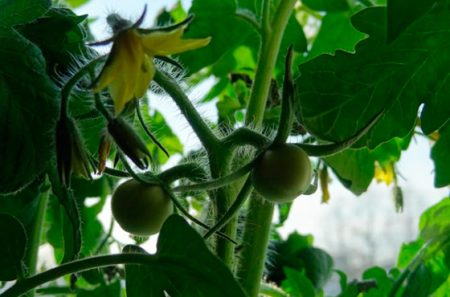 The final processing is carried out after the formation of ovaries on tomatoes. For 10 liters of water, take a teaspoon of ammonia and a tablespoon of potassium sulfate. Stir components until complete dissolution and water the plants under the root. You can add a teaspoon of superphosphate to the supplement. It is very important that in addition to ammonia, other mineral components enter the fertilizer, since their deficiency provokes a slowdown in the ripening period of the fruits, and fruiting itself is extremely scarce.
The final processing is carried out after the formation of ovaries on tomatoes. For 10 liters of water, take a teaspoon of ammonia and a tablespoon of potassium sulfate. Stir components until complete dissolution and water the plants under the root. You can add a teaspoon of superphosphate to the supplement. It is very important that in addition to ammonia, other mineral components enter the fertilizer, since their deficiency provokes a slowdown in the ripening period of the fruits, and fruiting itself is extremely scarce.
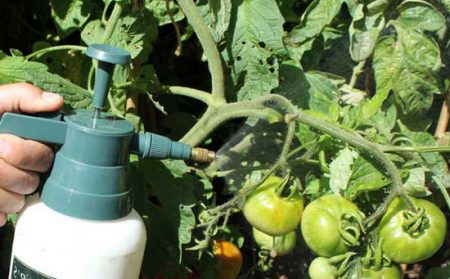 Some gardeners sometimes carry out a fourth subcortex, in composition it is identical to the third and is carried out at the end of summer - when the ripening of tomatoes is actively coming. To support productivity, such dressing comes in handy. However, if so many tomatoes are formed, then the use of fertilizer is not necessary.
Some gardeners sometimes carry out a fourth subcortex, in composition it is identical to the third and is carried out at the end of summer - when the ripening of tomatoes is actively coming. To support productivity, such dressing comes in handy. However, if so many tomatoes are formed, then the use of fertilizer is not necessary.
Tomato Pest Control
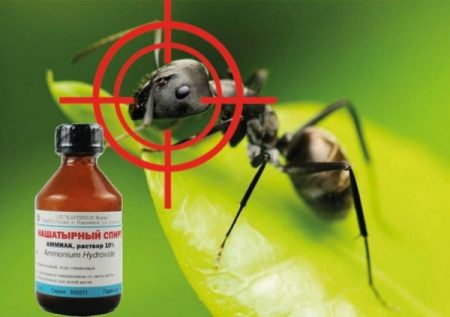 Since most insects do not tolerate a pungent odor, tomatoes are often treated with ammonia. In spring and early summer, a period of insect activity begins. So that the tomatoes do not become infected with aphids, caterpillars, midges, mites, they are irrigated with a 1% solution of ammonia. 10 milliliters of substance are taken per 10 liters of water and the plants are treated. The processing efficiency can be increased by adding laundry soap (2 tablespoons) to the original mixture. Alkaline environment is considered unfavorable for the development and activity of insects, and the pungent smell of ammonia will scare them away from tomatoes.
Since most insects do not tolerate a pungent odor, tomatoes are often treated with ammonia. In spring and early summer, a period of insect activity begins. So that the tomatoes do not become infected with aphids, caterpillars, midges, mites, they are irrigated with a 1% solution of ammonia. 10 milliliters of substance are taken per 10 liters of water and the plants are treated. The processing efficiency can be increased by adding laundry soap (2 tablespoons) to the original mixture. Alkaline environment is considered unfavorable for the development and activity of insects, and the pungent smell of ammonia will scare them away from tomatoes.
For the treatment of planting soil using an aqueous solution of ammonia. For 10 liters, it is enough to take 3 tablespoons of the substance and irrigate the land at the landing site. Such a mixture is harmful to slugs, snails, caterpillars. The first soil treatment is carried out immediately before planting, the procedure is repeated after 2-3 weeks at the end of May.
The interval between irrigation should be at least 10 days.
Reviews
Many gardeners have long discovered this miraculous remedy and are actively using it for root and foliar top dressing. The additive is very simple to prepare, it does not require infusion and can be used immediately after preparation. Although the tool is recognized as fast-acting and effective, it does not provide the main nutrition for tomatoes. Ammonium chloride is excellent for preventing insects and pests, and is also used as an additional source of nitrogen. However, it is recommended to combine it with other mineral complexes containing magnesium, manganese, potassium, iron, and organic components.
It is advised to apply ammonia from the very beginning of growing tomato seedlings - before planting seeds. Parasitizing microorganisms may also be present on the seeds to neutralize them, soak the grains in a 1% freshly prepared solution for 2 hours. When the seeds are disinfected, they are dried and planted in the ground.
Fertilizer is considered safe both for the soil and for the tomato fruits themselves. Unlike other chemically obtained fertilizers, ammonia does not accumulate in tomato pulp and in the ground. The tool is recognized as environmentally friendly and can be used when growing tomatoes, but only in diluted form and at a certain time.




 Low-growing tomatoes, without pinching: 5 of the most delicious varieties
Low-growing tomatoes, without pinching: 5 of the most delicious varieties Why tomato seedlings grow poorly
Why tomato seedlings grow poorly We grow a tomato in a shell
We grow a tomato in a shell Growing tomatoes without watering according to the method of Kazarin
Growing tomatoes without watering according to the method of Kazarin
I quote the author: “In spring and early summer, a period of insect activity begins. So that the tomatoes do not become infected with aphids, caterpillars, midges, mites, they are irrigated with a 1% solution of ammonia. 10 milliliters of substance are taken per 10 liters of water and the plants are treated. "
The calculation is not correct: to obtain a 1% solution, you should take 1 liter of a 10% solution of ammonia (and only 10% solution is sold in pharmacies) and add 9 liters of water - this will be 1% solution. With this solution you will burn everything and run away from the greenhouse from the smell of ammonia! THOSE. with a percentage you “went too far”